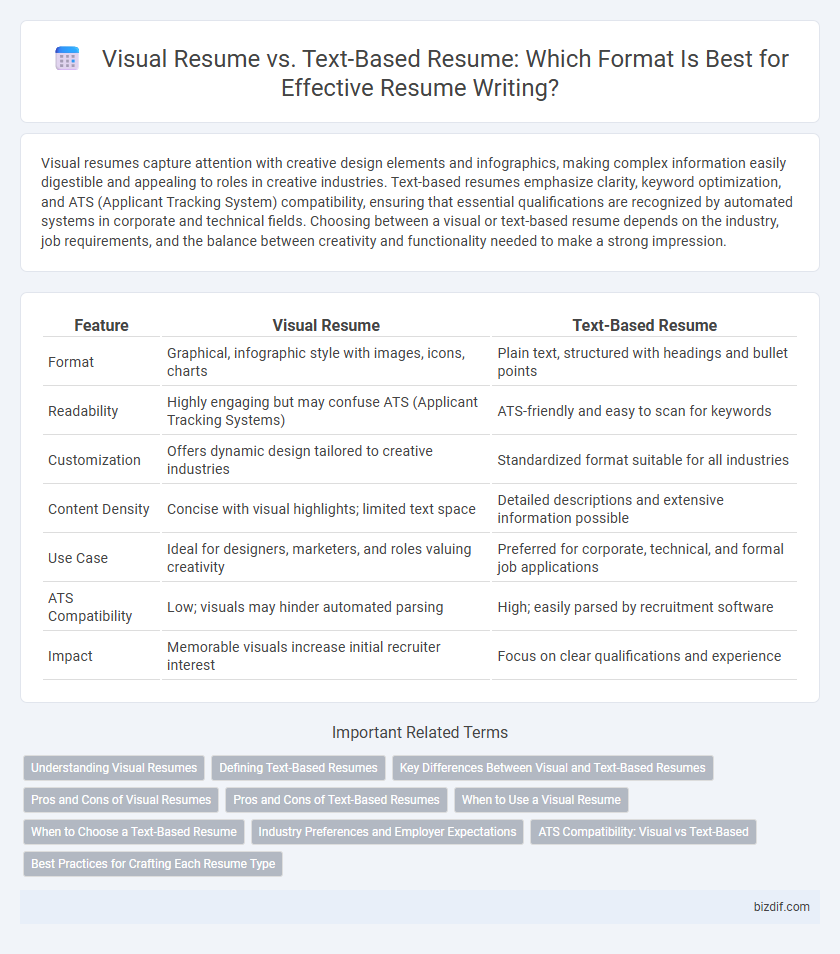Visual resumes capture attention with creative design elements and infographics, making complex information easily digestible and appealing to roles in creative industries. Text-based resumes emphasize clarity, keyword optimization, and ATS (Applicant Tracking System) compatibility, ensuring that essential qualifications are recognized by automated systems in corporate and technical fields. Choosing between a visual or text-based resume depends on the industry, job requirements, and the balance between creativity and functionality needed to make a strong impression.
Table of Comparison
| Feature | Visual Resume | Text-Based Resume |
|---|---|---|
| Format | Graphical, infographic style with images, icons, charts | Plain text, structured with headings and bullet points |
| Readability | Highly engaging but may confuse ATS (Applicant Tracking Systems) | ATS-friendly and easy to scan for keywords |
| Customization | Offers dynamic design tailored to creative industries | Standardized format suitable for all industries |
| Content Density | Concise with visual highlights; limited text space | Detailed descriptions and extensive information possible |
| Use Case | Ideal for designers, marketers, and roles valuing creativity | Preferred for corporate, technical, and formal job applications |
| ATS Compatibility | Low; visuals may hinder automated parsing | High; easily parsed by recruitment software |
| Impact | Memorable visuals increase initial recruiter interest | Focus on clear qualifications and experience |
Understanding Visual Resumes
Visual resumes leverage graphic elements such as charts, icons, and color schemes to highlight key skills, achievements, and career milestones, making complex information easy to digest and visually appealing. They cater to industries like design, marketing, and creative fields where visual communication skills are crucial, enhancing candidate visibility in applicant tracking systems optimized for multimedia content. Understanding the strategic use of layout and infographics in visual resumes can significantly boost engagement by showcasing proficiency and personality beyond traditional text-based formats.
Defining Text-Based Resumes
Text-based resumes emphasize clear, concise content with a focus on skills, experience, and education presented in a straightforward format optimized for Applicant Tracking Systems (ATS). They prioritize keyword-rich descriptions and structured layouts that enhance readability for recruiters and automated screening software. This format improves compatibility across various platforms, increasing the chances of passing initial resume scans.
Key Differences Between Visual and Text-Based Resumes
Visual resumes leverage graphics, colors, and layout to highlight skills and achievements, making them ideal for creative industries that value design and innovation. Text-based resumes rely on structured formatting and clear, concise language, which suits traditional fields and applicant tracking systems (ATS) by ensuring easy readability and keyword optimization. The key difference lies in visual impact and ATS compatibility, where visual resumes attract human attention but may struggle with ATS parsing, while text-based resumes prioritize compatibility and straightforward presentation.
Pros and Cons of Visual Resumes
Visual resumes enhance candidate visibility by integrating graphics, charts, and colors that highlight key skills and achievements, making them ideal for creative industries. However, they may face compatibility issues with applicant tracking systems (ATS), potentially limiting their effectiveness in automated hiring processes. Despite aesthetic appeal, visual resumes can overwhelm recruiters if cluttered, so a balance between design and readability is essential.
Pros and Cons of Text-Based Resumes
Text-based resumes offer simplicity and easy compatibility with applicant tracking systems (ATS), ensuring that key skills and qualifications are accurately parsed. They allow for straightforward customization and are preferred in industries valuing traditional professionalism. However, text-based resumes may lack visual appeal and fail to showcase creativity, potentially making it harder to stand out in competitive job markets.
When to Use a Visual Resume
Visual resumes are most effective for creative professionals such as designers, marketers, and artists who benefit from showcasing their portfolios and design skills. They work well in industries where visual impact can differentiate candidates and demonstrate creativity. Use a visual resume when applying for roles that value innovative presentation and when submitting materials digitally to highlight unique talents.
When to Choose a Text-Based Resume
Text-based resumes are essential when applying through Applicant Tracking Systems (ATS) that require keyword optimization and straightforward formatting to ensure proper parsing. Traditional industries such as finance, law, or government often prefer text-based resumes for their professionalism and compatibility with standard hiring protocols. For roles emphasizing experience and qualifications over creativity, a clear, concise text-based resume enhances readability and aligns with recruiters' expectations.
Industry Preferences and Employer Expectations
Visual resumes are increasingly favored in creative industries such as marketing, design, and media where employer expectations emphasize visual storytelling and innovative presentation. Text-based resumes remain the standard in traditional sectors like finance, law, and engineering, prioritizing clear, concise information and keyword optimization for applicant tracking systems (ATS). Industry preferences dictate that candidates tailor their resumes to meet employer expectations, balancing creativity with professionalism to enhance hiring prospects.
ATS Compatibility: Visual vs Text-Based
Text-based resumes excel in ATS compatibility by using simple formatting and keywords that are easily parsed by applicant tracking systems, ensuring higher chances of being shortlisted. Visual resumes, while visually appealing, often include complex designs, graphics, and non-standard fonts that can confuse ATS algorithms, leading to potential rejection. Prioritizing a clean, text-focused format enhances the resume's ability to pass ATS filters and reach hiring managers effectively.
Best Practices for Crafting Each Resume Type
Visual resumes should emphasize clear, concise summaries supported by eye-catching graphics and clean layouts, ensuring key qualifications and achievements stand out to recruiters. Text-based resumes require strong keyword integration, logical structure, and quantifiable accomplishments to effectively pass Applicant Tracking Systems (ATS) and appeal to hiring managers. Both formats benefit from tailored content specific to the job description, professional fonts, and careful proofreading to enhance readability and impact.
Visual Resume vs Text-Based Resume Infographic

 bizdif.com
bizdif.com